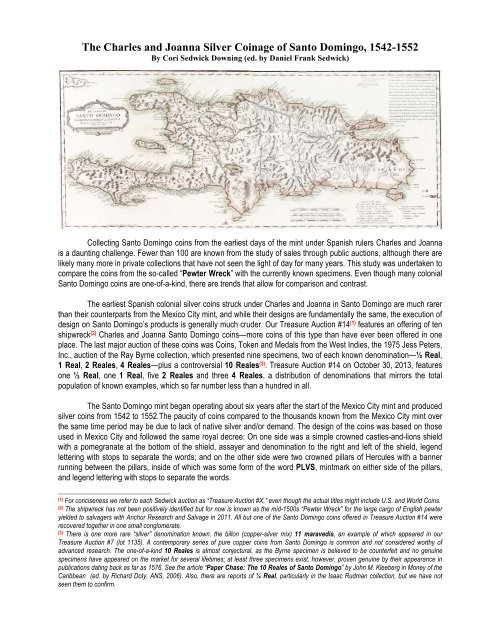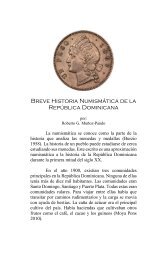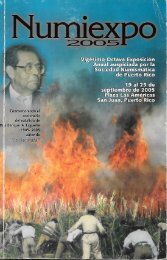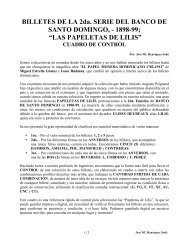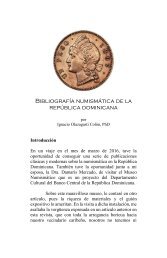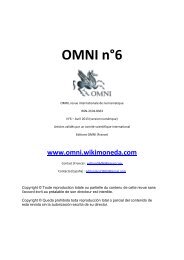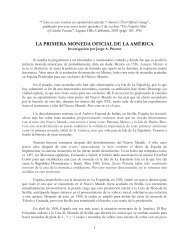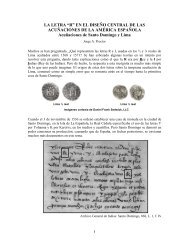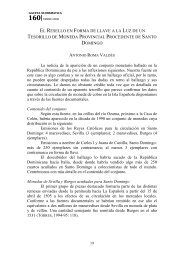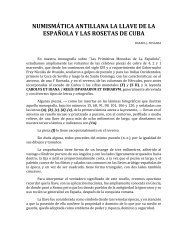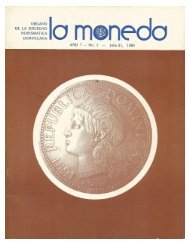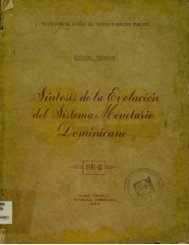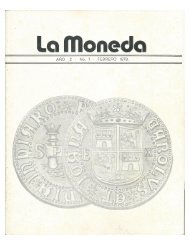The Charles and Joanna Silver Coinage of Santo Domingo-Ed SND
Estudio comparativo de las piezas de la coleccion “Pewter Wreck” con las otras pocas pizas conocidas publicamente.
Estudio comparativo de las piezas de la coleccion “Pewter Wreck” con las otras pocas pizas conocidas publicamente.
Create successful ePaper yourself
Turn your PDF publications into a flip-book with our unique Google optimized e-Paper software.
<strong>The</strong> <strong>Charles</strong> <strong>and</strong> <strong>Joanna</strong> <strong>Silver</strong> <strong>Coinage</strong> <strong>of</strong> <strong>Santo</strong> <strong>Domingo</strong>, 1542-1552<br />
By Cori Sedwick Downing (ed. by Daniel Frank Sedwick)<br />
Collecting <strong>Santo</strong> <strong>Domingo</strong> coins from the earliest days <strong>of</strong> the mint under Spanish rulers <strong>Charles</strong> <strong>and</strong> <strong>Joanna</strong><br />
is a daunting challenge. Fewer than 100 are known from the study <strong>of</strong> sales through public auctions, although there are<br />
likely many more in private collections that have not seen the light <strong>of</strong> day for many years. This study was undertaken to<br />
compare the coins from the so-called “Pewter Wreck” with the currently known specimens. Even though many colonial<br />
<strong>Santo</strong> <strong>Domingo</strong> coins are one-<strong>of</strong>-a-kind, there are trends that allow for comparison <strong>and</strong> contrast.<br />
<strong>The</strong> earliest Spanish colonial silver coins struck under <strong>Charles</strong> <strong>and</strong> <strong>Joanna</strong> in <strong>Santo</strong> <strong>Domingo</strong> are much rarer<br />
than their counterparts from the Mexico City mint, <strong>and</strong> while their designs are fundamentally the same, the execution <strong>of</strong><br />
design on <strong>Santo</strong> <strong>Domingo</strong>’s products is generally much cruder. Our Treasure Auction #14 (1) features an <strong>of</strong>fering <strong>of</strong> ten<br />
shipwreck (2) <strong>Charles</strong> <strong>and</strong> <strong>Joanna</strong> <strong>Santo</strong> <strong>Domingo</strong> coins—more coins <strong>of</strong> this type than have ever been <strong>of</strong>fered in one<br />
place. <strong>The</strong> last major auction <strong>of</strong> these coins was Coins, Token <strong>and</strong> Medals from the West Indies, the 1975 Jess Peters,<br />
Inc., auction <strong>of</strong> the Ray Byrne collection, which presented nine specimens, two <strong>of</strong> each known denomination—½ Real,<br />
1 Real, 2 Reales, 4 Reales—plus a controversial 10 Reales (3) . Treasure Auction #14 on October 30, 2013, features<br />
one ½ Real, one 1 Real, five 2 Reales <strong>and</strong> three 4 Reales, a distribution <strong>of</strong> denominations that mirrors the total<br />
population <strong>of</strong> known examples, which so far number less than a hundred in all.<br />
<strong>The</strong> <strong>Santo</strong> <strong>Domingo</strong> mint began operating about six years after the start <strong>of</strong> the Mexico City mint <strong>and</strong> produced<br />
silver coins from 1542 to 1552.<strong>The</strong> paucity <strong>of</strong> coins compared to the thous<strong>and</strong>s known from the Mexico City mint over<br />
the same time period may be due to lack <strong>of</strong> native silver <strong>and</strong>/or dem<strong>and</strong>. <strong>The</strong> design <strong>of</strong> the coins was based on those<br />
used in Mexico City <strong>and</strong> followed the same royal decree: On one side was a simple crowned castles-<strong>and</strong>-lions shield<br />
with a pomegranate at the bottom <strong>of</strong> the shield, assayer <strong>and</strong> denomination to the right <strong>and</strong> left <strong>of</strong> the shield, legend<br />
lettering with stops to separate the words; <strong>and</strong> on the other side were two crowned pillars <strong>of</strong> Hercules with a banner<br />
running between the pillars, inside <strong>of</strong> which was some form <strong>of</strong> the word PLVS, mintmark on either side <strong>of</strong> the pillars,<br />
<strong>and</strong> legend lettering with stops to separate the words.<br />
-------------------------------------------------------------------------------------<br />
(1)<br />
For conciseness we refer to each Sedwick auction as “Treasure Auction #X,” even though the actual titles might include U.S. <strong>and</strong> World Coins.<br />
(2)<br />
<strong>The</strong> shipwreck has not been positively identified but for now is known as the mid-1500s “Pewter Wreck” for the large cargo <strong>of</strong> English pewter<br />
yielded to salvagers with Anchor Research <strong>and</strong> Salvage in 2011. All but one <strong>of</strong> the <strong>Santo</strong> <strong>Domingo</strong> coins <strong>of</strong>fered in Treasure Auction #14 were<br />
recovered together in one small conglomerate.<br />
(3)<br />
<strong>The</strong>re is one more rare “silver” denomination known, the billon (copper-silver mix) 11 maravedís, an example <strong>of</strong> which appeared in our<br />
Treasure Auction #7 (lot 1135). A contemporary series <strong>of</strong> pure copper coins from <strong>Santo</strong> <strong>Domingo</strong> is common <strong>and</strong> not considered worthy <strong>of</strong><br />
advanced research. <strong>The</strong> one-<strong>of</strong>-a-kind 10 Reales is almost conjectural, as the Byrne specimen is believed to be counterfeit <strong>and</strong> no genuine<br />
specimens have appeared on the market for several lifetimes; at least three specimens exist, however, proven genuine by their appearance in<br />
publications dating back as far as 1576. See the article “Paper Chase: <strong>The</strong> 10 Reales <strong>of</strong> <strong>Santo</strong> <strong>Domingo</strong>” by John M. Kleeberg in Money <strong>of</strong> the<br />
Caribbean (ed. by Richard Doty, ANS, 2006). Also, there are reports <strong>of</strong> ¼ Real, particularly in the Isaac Rudman collection, but we have not<br />
seen them to confirm.
Unlike the coins from the Mexico City mint, there seems to be no consistency in placement <strong>of</strong> devices such as<br />
assayer, denomination, or mintmarks on the <strong>Santo</strong> <strong>Domingo</strong> coins; placement <strong>of</strong> castles <strong>and</strong> lions in the quadrants<br />
(“proper” being castles top-left <strong>and</strong> bottom-right, “transposed” being lions top-left <strong>and</strong> bottom-right); style <strong>of</strong> lettering<br />
(Gothic, modified Gothic, Latin); or even what the lettering spelled out. For example, <strong>of</strong> the twenty-nine known 2<br />
Reales, there are fifteen different legends on the pillars side <strong>of</strong> the coins. And, curiously, the <strong>Santo</strong> <strong>Domingo</strong> mint<br />
chose to spell the co-regent’s name as IHOANA or IYOANA (or variants there<strong>of</strong>) instead <strong>of</strong> IOHANA, as was the<br />
convention in Mexico City. Even the predominant stop <strong>of</strong> ♣ used in <strong>Santo</strong> <strong>Domingo</strong> was unknown in Mexico City.<br />
Apparently the mint was given some leeway in its creation <strong>and</strong> use <strong>of</strong> design features not spelled out in the royal<br />
decree.<br />
Assayer F, for Francisco Rodríguez, was the only assayer <strong>of</strong> <strong>Santo</strong> <strong>Domingo</strong> <strong>Charles</strong> <strong>and</strong> <strong>Joanna</strong> coinage.<br />
His initial does not appear on the ½ Real, is sometimes missing from the 1 <strong>and</strong> 2 Reales, <strong>and</strong> always appears on the 4<br />
Reales. <strong>The</strong> denomination on the opposite side <strong>of</strong> the shield from his initial follows the same pattern. On the other<br />
h<strong>and</strong>, S <strong>and</strong> P, the mintmarks for <strong>Santo</strong> <strong>Domingo</strong>, almost always appear on the pillars side <strong>of</strong> the coins, either as S-P<br />
or P-S (<strong>and</strong> <strong>of</strong>ten with retrograde S). Why S-P for <strong>Santo</strong> <strong>Domingo</strong>? No one knows for sure, the leading theories being<br />
that the original name <strong>of</strong> the city was <strong>Santo</strong> <strong>Domingo</strong> del Puerto <strong>and</strong> also bore the nickname <strong>Santo</strong> <strong>Domingo</strong><br />
Ciudad Primada; but in any case the theory that Spain didn’t send a D punch is certainly not valid, as the letter D<br />
properly appears in the legends.<br />
<strong>The</strong> following is a summary <strong>of</strong> variations on the coins by denomination <strong>and</strong> how Treasure Auction #14 coins fit<br />
within that context:<br />
½ Real (Treasure Auction #14, lot 332)<br />
Lot 332<br />
<strong>The</strong>re are four die varieties for the fourteen ½ Real coins studied with two varieties containing only one coin.<br />
Nine coins fall into the most common variety, <strong>and</strong> Lot 332 falls into the less common variety <strong>of</strong> the four (<strong>of</strong> which there<br />
are three coins). <strong>The</strong> differences between the varieties are the types <strong>of</strong> stop between the lettering in the legends <strong>and</strong><br />
the legends themselves (one <strong>of</strong> the unique coins also bears a different interior on the pillars side). <strong>The</strong> more common<br />
stop is ♣, which is typical <strong>of</strong> other denominations, while the less common stop is o (unknown on any other<br />
denomination). <strong>The</strong> unique coins have stops with multiples <strong>of</strong> the o ornament in different arrangements, some unseen<br />
elsewhere.<br />
<strong>The</strong> legends <strong>of</strong> the most common variety read ♣C/\R♣OLVS♣ET♣IHO/\N/\R✠ on the shield side <strong>and</strong><br />
♣C/\R♣OLVS♣ET♣IHO/\N/\R✠ on the pillars side. <strong>The</strong> legends <strong>of</strong> the less common variety read<br />
♣C/\ROLVSoEToIHoo/\N/\oREISIP/\ on the shield side <strong>and</strong> ♣C/\ROLVSoEToIHO/\N/\oREISIP on the pillars side.<br />
<strong>The</strong> legends <strong>of</strong> the unique coins have a motto all their own.<br />
In general, the two more common varieties are characterized by Latin lettering in the legends with the use <strong>of</strong> a<br />
makeshift A created by inverting the letter V (here represented as /\); crowned pillars containing a horizontal banner<br />
with only a P inside, flanked on the outside by mintmark P-S; <strong>and</strong> a crowned Gothic KY (although the initials more<br />
resemble modern RV) for the regents’ initials on the interior <strong>of</strong> the other side. <strong>The</strong> unique coins tend toward a more<br />
Gothic style <strong>of</strong> lettering or a mixture <strong>of</strong> Gothic <strong>and</strong> Latin. <strong>The</strong>se coins are a virtual hodgepodge <strong>and</strong> may have been<br />
early experiments at the mint.<br />
Lot 332 has a variation seen on only one other coin (from the same shipwreck but not in the auction): beneath the KY<br />
on the interior <strong>of</strong> the shield side is a flower with petals. All other varieties have ♣♣ (two clovers, one on top <strong>of</strong> the other,<br />
stem-to-stem), a device seen again as a stop on the 2 Reales.
1 Real (Treasure Auction #14, lot 331)<br />
Lot 331<br />
Twenty 1 Reales were studied, one being Lot 331. <strong>The</strong>se coins are characterized by hybridized lettering in<br />
the legends—partly Gothic <strong>and</strong> partly Latin. On the shield side, the legend reads CAROLVS ET IOHANA in some<br />
manner, <strong>and</strong> the only device used as a stop is the ♣, with the exception <strong>of</strong> Lot 331 <strong>and</strong> another coin that reads<br />
CAROLVSETIHOANA : RE. <strong>The</strong>re are five varieties <strong>of</strong> legend lettering (fewer than with 2 <strong>and</strong> 4 Reales), with six coins<br />
falling into a single variety. <strong>The</strong>re are ten varieties <strong>of</strong> legend lettering on the pillars side (more in line with the amount <strong>of</strong><br />
variety with 2 <strong>and</strong> 4 Reales), two <strong>of</strong> which are the most common (eight coins total) <strong>and</strong> the others unique or almost<br />
unique. Some legends bear a makeshift A by inverting the letter V.<br />
<strong>The</strong> shields contain castles <strong>and</strong> lions in proper or transposed quadrants, beneath which is a pomegranate<br />
whose compartment is either wide or narrow. Most <strong>of</strong> the time there is no assayer or denomination to the left <strong>and</strong> right<br />
<strong>of</strong> the shield (eight coins, one <strong>of</strong> which is Lot 331). <strong>The</strong>re is a 3-dot variety in which the dots are aligned vertically to<br />
the left <strong>and</strong> the right <strong>of</strong> the shield (five coins). It is unknown why this convention was adopted <strong>and</strong> it certainly doesn’t fit<br />
with the type <strong>of</strong> denomination marks found on the 2 <strong>and</strong> 4 Reales.<br />
<strong>The</strong> pillars-side legends contain ten variations, most <strong>of</strong> them spelling out some form <strong>of</strong> CAROLVS ET<br />
IHOANA RE, preceded by the cross ornament ✠ (note the 2 <strong>and</strong> 4 Reales have two types <strong>of</strong> cross ornament), while<br />
the others show some form <strong>of</strong> REGIS ISPANIARVM INDIARVN. Misspellings abound. Retrograde S’s in REGIS <strong>and</strong><br />
ISPANIARVM are found on a few coins. Two coins bear a makeshift A made by inverting a V. <strong>The</strong> legend on Lot 331<br />
reads CRAOLVS ET IHOANAREGESIS.<br />
On the pillars-side interior, crowned pillars contain a banner with initials P or S (or retrograde S) to the left, P<br />
or S to the right, <strong>and</strong> PL, PLV or LV within the banner. Sometimes the S <strong>and</strong> P are larger than the other letters, <strong>and</strong><br />
sometimes they are positioned above the banner. <strong>The</strong>re are eight crown styles, with two the most common <strong>and</strong> the<br />
others unique or almost unique. This is similar to the number <strong>of</strong> crown styles on 2 <strong>and</strong> 4 Reales. Lot 331 falls into a<br />
style shared by only one other coin.<br />
<strong>The</strong>re are two types <strong>of</strong> stops used in the legends on either or both sides <strong>of</strong> the coin to separate words: the<br />
predominant stop, ♣, <strong>and</strong> :, which is found on only five coins, one <strong>of</strong> which is Lot 331, <strong>and</strong> is the only specimen to<br />
contain: on both sides. Also unusual on this coin is the mistaken spelling CRAOLVS instead <strong>of</strong> CAROLVS in the pillars<br />
side legend; there is only one other coin with this mistake <strong>and</strong> two are known on the 2 Reales.
2 Reales (Treasure Auction #14, lots 326, 327, 328, 329 <strong>and</strong> 330)<br />
Lot 326<br />
<strong>The</strong>re are twenty-nine 2 Reales in the population census, five <strong>of</strong> which are included in this auction. <strong>The</strong>se <strong>and</strong><br />
the 4 Reales are the most common denominations <strong>of</strong> <strong>Santo</strong> <strong>Domingo</strong> silver coinage. <strong>The</strong>y also have the largest variety<br />
<strong>of</strong> lettering styles, stops used between words in the legends, <strong>and</strong> pillar crown types. Some <strong>of</strong> the legends contain<br />
primarily Gothic lettering while others are a mix <strong>of</strong> Gothic <strong>and</strong> Latin lettering <strong>and</strong> all spell out CAROLVS ET IOHANA in<br />
some manner on the shield side. <strong>The</strong> types <strong>of</strong> devices used for stops on both sides include ♣, ♣♣ (two clovers, one on<br />
top <strong>of</strong> the other, stem-to-stem), ▲, *, :, ●, a triangle made <strong>of</strong> o’s, <strong>and</strong> a cross made <strong>of</strong> four o’s (a unique variety). By<br />
far, the most common shield-side stops are the ♣♣ (nine coins). On this variety, the mixture <strong>of</strong> Gothic <strong>and</strong> Latin<br />
lettering reads CAROLVS♣♣ET♣♣ IYOANA. Lot 328 bears this legend while the other four auction coins have four<br />
different legends with two being unique. <strong>The</strong>re are also two coins bearing the lettering CHAROLVS on the pillars side,<br />
<strong>and</strong> these are probably earlier types since they also use Gothic lettering. While several coins bear a retrograde S in<br />
CAROLVS (including Lots 327 <strong>and</strong> 328), none bears the makeshift A made from an inverted Von the shield side. Only<br />
one coin bears a different style <strong>of</strong> E from the norm, more like a modified Gothic letter. One auction coin, Lot 330, is<br />
probably an early type given that the lettering on both sides is Gothic.<br />
Lot 327<br />
<strong>The</strong> shield contains castles <strong>and</strong> lions in proper or transposed quadrants, beneath which is a pomegranate<br />
whose compartment is either wide or narrow. <strong>The</strong> assayer’s F is either to the left or right <strong>of</strong> the shield <strong>and</strong> the<br />
denomination (ll) is on the opposite side. Two <strong>of</strong> the coins bear neither F nor ll. Of the two predominant styles, four out<br />
<strong>of</strong> five <strong>of</strong> the auction coins fall into one or the other. <strong>The</strong> fifth, Lot 328, contains a unique combination.<br />
Pillars-side legends are quite variable with fifteen different legends recorded. None is a clear favorite. Even<br />
what the legend says is capricious, with nine legends containing some form <strong>of</strong> CAROLVS ET IHOANA REIS <strong>and</strong> six<br />
containing some form <strong>of</strong> REGIS ISPANIA INDIARVN. Two cross types appear before CAROLVS or REGIS, ✠ or ✚.
Lot 328<br />
<strong>The</strong>re are misspellings <strong>and</strong> omitted letters on several. <strong>The</strong> unusual E appears on a few coins, including two <strong>of</strong><br />
the auction coins, Lot 328 <strong>and</strong> Lot 329, as does the retrograde S in REGIS <strong>and</strong> ISPANIARVM. A few coins bear the<br />
makeshift A.<br />
On the interior <strong>of</strong> the pillars side, there are ten crown-style variations above the Pillars <strong>of</strong> Hercules, the only<br />
clear favorite being a style found in five coins, three <strong>of</strong> which are in the auction: Lot 327, Lot 328, <strong>and</strong> Lot 329.<strong>The</strong><br />
mintmarks <strong>and</strong> banner mottos begin with S or retrograde S, P, oPo, *P* or *P followed by PLVS, PLV, LVS, PL, LV or<br />
PV within the banner. To the right <strong>of</strong> the banner is P, S, oSo, *S, or oP. Sometimes the S <strong>and</strong> P are much larger than<br />
the other lettering, <strong>and</strong> sometimes they are positioned above the height <strong>of</strong> the banner. <strong>The</strong> auction coins fall within<br />
three crown styles, the most common <strong>of</strong> which is what the three coins mentioned above fall into. Curiously, one pillarsside<br />
die shows an arch linking the tops <strong>of</strong> the crowns, with *-P to left, *-S to right <strong>and</strong> a row <strong>of</strong> three *’s at bottom (four<br />
coins bear this, none <strong>of</strong> which is an auction coin).<br />
Lot 329<br />
Lot 330
4 Reales (Treasure Auction #14, lots 323, 324<strong>and</strong> 325)<br />
Lot 323<br />
As with the 1 <strong>and</strong> 2 Reales, the execution <strong>of</strong> design on the thirty 4 Reales studied is widely variable. Legend<br />
lettering on both sides can be Gothic, a mixture <strong>of</strong> Gothic <strong>and</strong> Latin, or Latin. <strong>The</strong>re are five census coins (but no<br />
auction coins), which contain Gothic lettering on both sides, clearly early mint products. Spelling errors are similar to 2<br />
Reales coins with instances <strong>of</strong> CHAROLVS <strong>and</strong> YOHANA. On the shield side, only one <strong>of</strong> the twelve lettering styles<br />
predominates (with six coins), <strong>and</strong> the three auction coins are not <strong>of</strong> this style. Stops between words on the shield side<br />
are ♣, ▲ <strong>and</strong> a cross-made <strong>of</strong> four o’s. <strong>The</strong> shield-side legends read CAROLVS ET IHOANA RE with several<br />
variations. Some legends bear a retrograde S at the end <strong>of</strong> CAROLVS <strong>and</strong> some bear the makeshift A (all three<br />
auction coins have one or more <strong>of</strong> these characteristics).<br />
Just as with the 1 <strong>and</strong> 2 Reales, the shield is composed <strong>of</strong> either proper or transposed castles <strong>and</strong> lions, with<br />
a pomegranate inside either a wide or narrow compartment below, <strong>and</strong> the assayer F <strong>and</strong> denomination to either the<br />
left or right <strong>of</strong> the shield. <strong>The</strong>re is also a probable early type <strong>of</strong> assayer F mark on three coins —an F with an elongated<br />
tail. <strong>The</strong> denomination invariably appears as ollll. <strong>The</strong> predominant two designs are: F-ollll, proper castles <strong>and</strong> lions,<br />
wide pomegranate (Lot 323 <strong>and</strong> Lot 325); <strong>and</strong> F-ollll, transposed castles <strong>and</strong> lions, narrow pomegranate. Lot 324 is<br />
one <strong>of</strong> two coins with the denomination to the left <strong>and</strong> F to the right.<br />
Lot 324<br />
Ten lettering variations are found on the pillars side <strong>of</strong> the coins. Some form <strong>of</strong> C(H)AROLVS ET IHOANA RE<br />
or REGIS ISPANIA ET INDIARVN is spelled out with three different variations <strong>of</strong> stops between words: ♣, : <strong>and</strong> a<br />
cross made with four o’s. Lettering is Gothic, a mixture <strong>of</strong> Gothic <strong>and</strong> Latin, or Latin. <strong>The</strong> cross before the lettering is<br />
either ✠ or ✚. No one style predominates <strong>and</strong> some <strong>of</strong> the coins bearing Gothic lettering are unique. <strong>The</strong>se coins,<br />
combined with the elements on the shield side, were clearly made early in the minting process. <strong>The</strong>se are also the<br />
coins that bear the early style <strong>of</strong> assayer mark. <strong>The</strong> auction coins fall into the later styles.
Lot 325<br />
<strong>The</strong>re are nine crown style variations on the pillars side with one style found on eight coins, one <strong>of</strong> which is<br />
Lot 323. As with the other denominations, the mintmark can be S or retrograde S to the left, <strong>and</strong> P to the right <strong>of</strong> the<br />
pillars, or the opposite. In some cases, the S <strong>and</strong> P are elevated above the banner between the pillars. In the earliest<br />
coins, there are three o’s in a triangle above <strong>and</strong> below the S <strong>and</strong> P. Within the banner are PL, PLV, LV, or PLVS.<br />
Somewhat confusingly, three coins (including two auction coins, Lot 324 <strong>and</strong> Lot 325) bear P <strong>and</strong> S within the banner<br />
(motto) <strong>and</strong> to the left <strong>and</strong> right <strong>of</strong> the pillars (mintmark). Lot 325 is probably a die match with two other coins studied:<br />
VQR #6831 (which is also Burzio #824) (4) ; <strong>and</strong> Lot 1547 from our Treasure Auction #8. Lot 324 is a probable die<br />
match with Estrella #2 (which is also Calicó #92). (5)<br />
-------------------------------------------------------------------------------------<br />
(4) VQR refers to Vidal Quadras y Ramón, Manuel. - Catálogo de la Colección de Monedas y Medallas de Manuel Vidal Quadras y Ramón, de<br />
Barcelona, (1892).<br />
Burzio refers to Burzio, Humberto F. - Diccionario de la Moneda Hispanoamericana, (1958).<br />
(5) Estrella refers to Estrella Gómez, Miguel. - Monedas Dominicanas, (1979).<br />
Calicó refers to Calicó, X. - Numismática Española, (2008).
<strong>The</strong> following is a list <strong>of</strong> <strong>Charles</strong> <strong>and</strong> <strong>Joanna</strong> <strong>Santo</strong> <strong>Domingo</strong> silver coins sold at auction. It is not exhaustive<br />
or complete but gives the reader an idea <strong>of</strong> how few coins ever reach the market. <strong>The</strong> other coins used for this study<br />
are listed in general reference works such as Burzio, Calicó, Estrella, Paoletti, <strong>and</strong> VQR. A few others were from the<br />
collection <strong>of</strong> Isaac Rudman, who kindly allowed them to be studied.<br />
<strong>Charles</strong> <strong>and</strong> <strong>Joanna</strong> <strong>Santo</strong> <strong>Domingo</strong> <strong>Silver</strong> Coins Sold at Auction<br />
1/2 Real<br />
• Lot 3722, Henry Christensen Auction <strong>of</strong> the Parsons Collection, March 1966<br />
• Lot 1108, Jess Peters Auction <strong>of</strong> Ray Byrne Collection, June 1975<br />
• Lot 1109, Jess Peters Auction <strong>of</strong> Ray Byrne Collection, June 1975<br />
• Lot 476, Ponterio & Wyatt Sale #4, June 1981<br />
• Lot 521, Freeman Craig & Co. Auction, November 1981<br />
• Lot 1705, Ponterio & Associates Auction #61, February 1993 (Estrella #5 plate coin <strong>and</strong> Lot #1108, Ray Byrne Collection)<br />
• Lot 1134, Sedwick Treasure Auction #7, April 2010<br />
• Lot 872, Sedwick Treasure Auction #11, April 2012<br />
1 Real<br />
• Lot 1106, Jess Peters Auction <strong>of</strong> Ray Byrne Ray Byrne Collection, June 1975<br />
• Lot 1107, Jess Peters Auction <strong>of</strong> Ray Byrne Collection, June 1975<br />
• Lot 1707, Ponterio & Associates Auction #61, February 1993 (Lot #1106, Ray Byrne Collection)<br />
• Lot 16859, Heritage Auction #410, June 2006 (Lot#1106, Ray Byrne Collection)<br />
2 Reales<br />
• Lot 1104, Jess Peters Auction <strong>of</strong> Ray Byrne Collection, June 1975<br />
• Lot 1105, Jess Peters Auction <strong>of</strong> Ray Byrne Collection, June 1975<br />
• Lot 705, Henry Christensen Auction #79, December 1981 (Estrella #1 plate coin <strong>and</strong> Byrne #1105)<br />
• Lot 162, Superior Galleries Auction <strong>of</strong> Paul Karon Collection, December 1992 (Paoletti #29 plate coin/Estrella #4 plate coin/Isaac<br />
Rudman #5672)<br />
• Lot 1707, Ponterio & Associates Auction #61, February 1993<br />
• Lot 1463, Ponterio & Associates Auction #96, September 1998<br />
• Lot 2139, Ponterio & Associates Auction #129, January 2004<br />
• Lot 2101, Ponterio & Associates Auction #137, January 2006<br />
• Lot 8230, Ponterio & Associates Auction #152, January 2010 (pedigreed to Lot 728, Ponterio & Associates Auction #147, September<br />
2008 <strong>and</strong> Lot 16860, Heritage Auction #410, June 2006)<br />
• Lot 1133, Sedwick Treasure Auction #7, April 2010 (pedigreed to Lot 2335, Ponterio & Associates Auction #93, March 1998)<br />
4 Reales<br />
• Lot 3721, Henry Christensen Auction <strong>of</strong> the Parsons Collection, March 1966 (probably Isaac Rudman coin #4647)<br />
• Lot 1102, Jess Peters Auction <strong>of</strong> Ray Byrne Collection, June 1975<br />
• Lot 1103, Jess Peters Auction <strong>of</strong> Ray Byrne Collection, June 1975<br />
• Lot 161, Superior Galleries Auction <strong>of</strong> Paul Karon Collection, December 1992 (die match to Lot 323,Sedwick Treasure Auction #14,<br />
October 2013)<br />
• Lot 1708, Ponterio & Associates Auction #61, February 1993 (Estrella #7 plate coin)<br />
• Lot 2474, Swiss Bank Corp Auction #39, January 1996 (Calicó #94 plate coin)<br />
• Lot 1488 Ponterio & Associates Auction #88, June 1997 (Paoletti #27 plate coin)<br />
• Lot 1162, Ponterio & Associates Auction #92, February 1998 (Calicó <strong>and</strong> Burzio #825 plate coin <strong>and</strong> pedigreed to Lot 12, Swiss Bank<br />
Corp Auction #27, September 1991; Lot 837,Christie’s Norweb Collection, May 1985, <strong>and</strong> Lot 422 Henry Christensen Auction, October<br />
1959)<br />
• Lot 87, Cayon Auction, December 2003 (Calicó <strong>and</strong> Paoletti #28 plate coin)<br />
• Lot 739, Stack’s Auction, January 2004<br />
• Lot 740, Stack’s Auction, January 2004 (Burzio #828 plate coin)<br />
• Lot 1547, Sedwick Treasure Auction #8, October 2010 (pedigreed to Lot 598, Ponterio Auction #108, August 2000)<br />
Acknowledgements<br />
<strong>The</strong> author would like to thank the following experts for their assistance: Freeman Craig, Carlos Jara, Jorge<br />
Proctor <strong>and</strong> Isaac Rudman.


